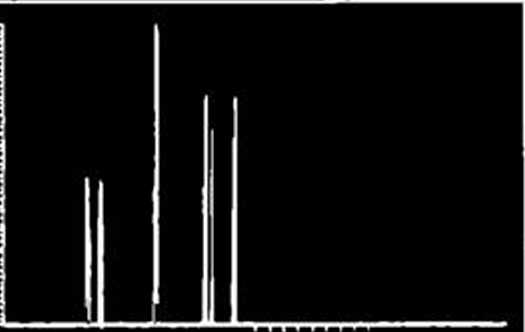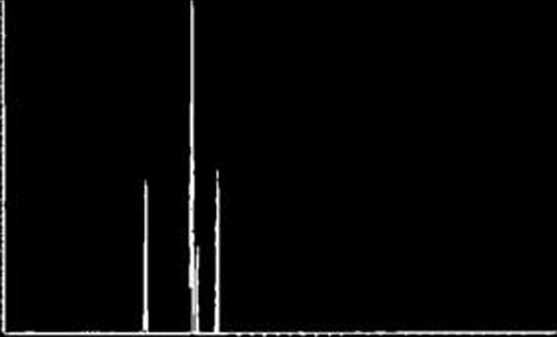117828253
Essential Oils of Sagę Species 187

Fig. 1. Fingerprint gas chromalograms obtained from HS-GC-MS analysis of the volatile fractions of S. lauandulifblm and S. triloba. Selected (i.e., most abundant and/or best separated) peaks are labelled in accordance with the numbering in Table I

13C NMR Spectroscopy
The 100 MHz 13C NMR spectrum obtained from the volatile compounds isolated from S. tńloba is shown in Fig. 2. The main ałiphatic part (Fig. 2a) ranges from 8 to 48 ppm, with some lines between 55 and 58.5 ppm. Several distinct lines are present in the region from 99 to 127 ppm (Fig. 2b) and three further lines are also observed between 140 and 150 ppm. This part of spectrum is typical of aromatic carbon, but in this mixture of essential oils the lines arise, respectively, from olefinic and quaternary carbons in cyclic or unsaturated environments.
To observe the increase in resolution, the 13C NMR spectrum of the volatile compounds derived from S. laoandulifolia was recorded at 150 MHz with forty-thousand seans; the spectrum is shown in Fig. 3. Now, the ali-phatic region of the spectrum (Fig. 3a), and the olefinic and quatemary re-gions (Fig. 3b), are nearly evenly covered with fine signals indicating the presence of a rich variety of products in a broad rangę of concentrations. Expansion of a portion of an ałiphatic region of the 150 MHz 13C NMR spectrum (Fig. 4) reveals excellent resolution of single Lines, indicating the pos-sibility of identification of individual products in the mixture. The spectrum recorded for S. laoandulifolia at 150 MHz has many features comparable with those for S. tńloba recorded at 100 MHz, and the differences are mainly
Wyszukiwarka
Podobne podstrony:
Essential Oils of Sagę Species 189 i Fig. 4.150 MHz l3C NMR spectrum of S. lavandulifolia in CDCb- E
Essential Oils of Sagę Species 183ExperimentalPlant Materiał Samples of the two Salina species (S.
4 M. Sajewicz et al. rial obtained was then stored until analysis in the deep-freeze compartment of
Low-Temperature TLC-MS of Essential Oils from Five Different Sagę (Sa/wa) Species Mieczysław Sajewlc
938 M. Sajewicz et nL Certain essential oils derived from sagę (e.g., S. Uwandulifolia) are composed
TLC-MS VERSUS TLC-LC-MS FINGERPRINTS OF HERBAL EXTRACTS. PART I. ESSENTIAL OILS Mieczysław Sajewicz1
4Vapor Distillation of Essentials Oils from the Salvia Species Dried plant materiał (50 g) was place
12 M. Sajewicz et al. From this comparison it is apparent that for three of the five sagę species in
15 Volatile Fraction from Sagę (Salvia L.) Species Table IV. Dependence on the method of extractiond
17 Volatile Fraction from Sagę (Salvia L.) Species Table VI. Dependence on the method of extractiond
19 Volatile Fraction from Sagę (Salvia /..) Species • Finally, it seems that morę detailed analysis
Low-Temperature TLC-MS of Essential Oils(1) 275 20)
Low Temperalure TLC-MS of Essentiai Oils 200
essent?rving?18 Essen tul Woodcarning Techniques Fig 1.29 A bench holdfast in use. Fig 1.28 A univer
essent?rving?30 Essen ti al Woodcarving Techniques Fig 2.4 A piece of Southern yeUow pine. The dark
essent?rving?47 First C i t s: Chip C a r v i n c, Fig 3.3 The depth of the stab cut. exercise. Cut
essent?rving?70 Essential Woodcaryinc Techntiques Fig 5.11 The top surface of the leaffinished, with
essent?rving?87 L I N F. N F O I. D Fig 7.13 Cutting along the top of the lower fołd.COLOUR AND FlNI
essent?rving?95 - C A R V I N G A COMMONPLACE OBJECT IN H I G H R; : .H Fig 8.15 Texturing the insid
więcej podobnych podstron